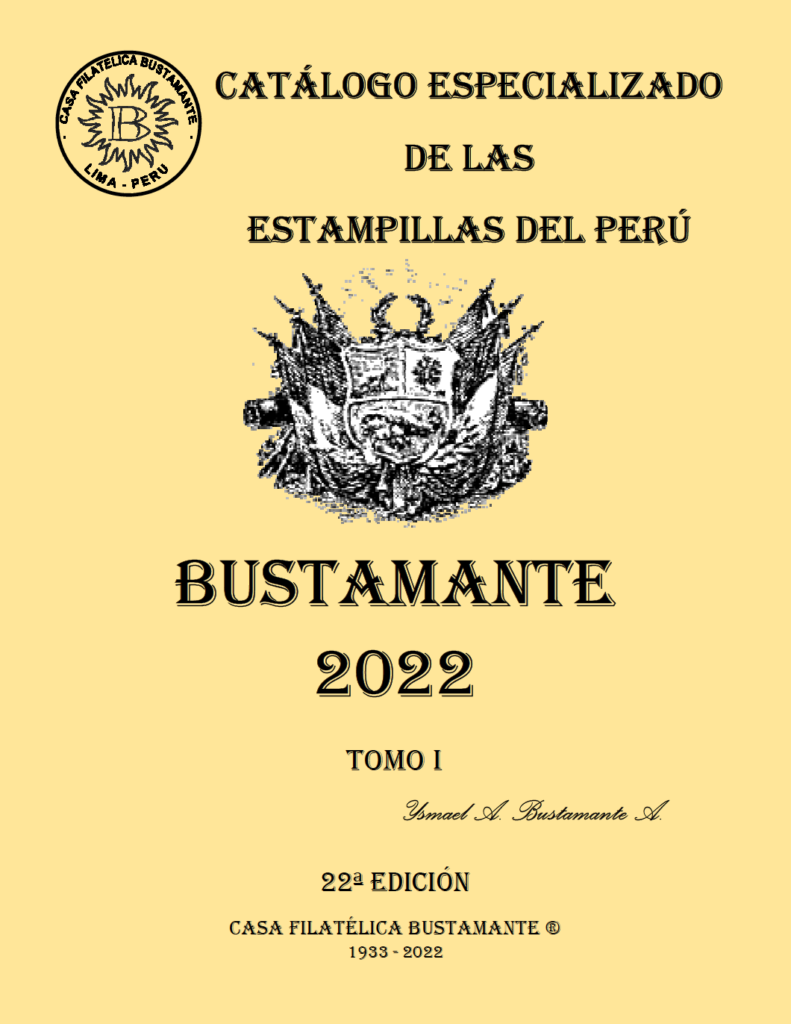
For three generations the Bustamante family has been producing both simplified and specialized catalogues for collectors of Peru. A new edition is planned for publication in 2022 (see details below).
In this article we discuss Peruvian catalogues and collecting Peru with Ysmael Bustamante, the grandson of the founder.
CLA The name “Bustamante” has been associated with Peruvian philately for many years. Can you explain the history of the company?
YB Casa Filatelica Bustamante was founded on 1st April 1933; but its relationship with Peruvian philately started many years earlier.
The founder was my grandfather, Gabriel O. Bustamante Rivarola.
He had been studying Peruvian philately since childhood and came to write numerous diverse articles on philately in specialized magazines.
An important contribution was the discovery of the 1 Dinero Rose Inverted Coat of Arms variety of 1862 (published in the very first edition of Filatelia Peruana in 1949).
Equally important was the discovery of the Type XI triangle overprint, used on some of the remaining stamps following the War of the Pacific.
My father, Juan G. Bustamante Frias, also contributed articles and then in 1965 began to publish the Catalogo de Estampillas del Peru, both in simplified and specialised editions. This culminated in his greatest work, the Specialized Catalogue of 1981, his last catalogue being published in 1984.
My father passed away in 1987. He also prepared an unpublished and unfinished work, Postmarks of the First Issues of Peru 1857-1876. I then added to this and finally published it in five volumes in 2018.
Between 1990 and 1994 we published an updated Specialized Catalogue, followed by simplified editions in 2004 (a supplement in 2005), once again in 2006 and a further supplement in 2015.
We continue to publish Peruvian catalogues and will be publishing a new edition of the Specialized Catalogue later this year, most likely in July.
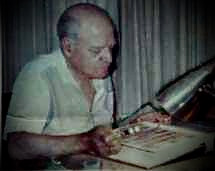
CLA How have the catalogues evolved over the years and how many editions have been published?
YB We have now published twenty-one editions. The forthcoming 22nd edition will cover new areas of Peruvian philately, as well as new sections that had not been previously incorporated.
Like everything in life, our catalogues evolve for the benefit of philatelists.
CLA How do the latest catalogues differ from the first editions?
YB The differences between the editions of our catalogues are principally based on the updated information we have gathered.
There is a regular and reliable source of contributions made by different scholars and collectors who, after each edition, kindly send us information.
After consultation, if the case merits it, we can add the respective notes to the next edition for the benefit of future collectors.
That is not to say that our studies are the last word on Peruvian philately. There are various scholars who are constantly publishing very good works on their studies that further enrich Peruvian philately in its different facets.
Our published catalogues and studies are just one more contribution to the whole range of publications on Peruvian philatelic studies.
However, we are very pleased with the preference and importance that our catalogues have with collectors of Peruvian stamps; not only at a national level but also internationally.
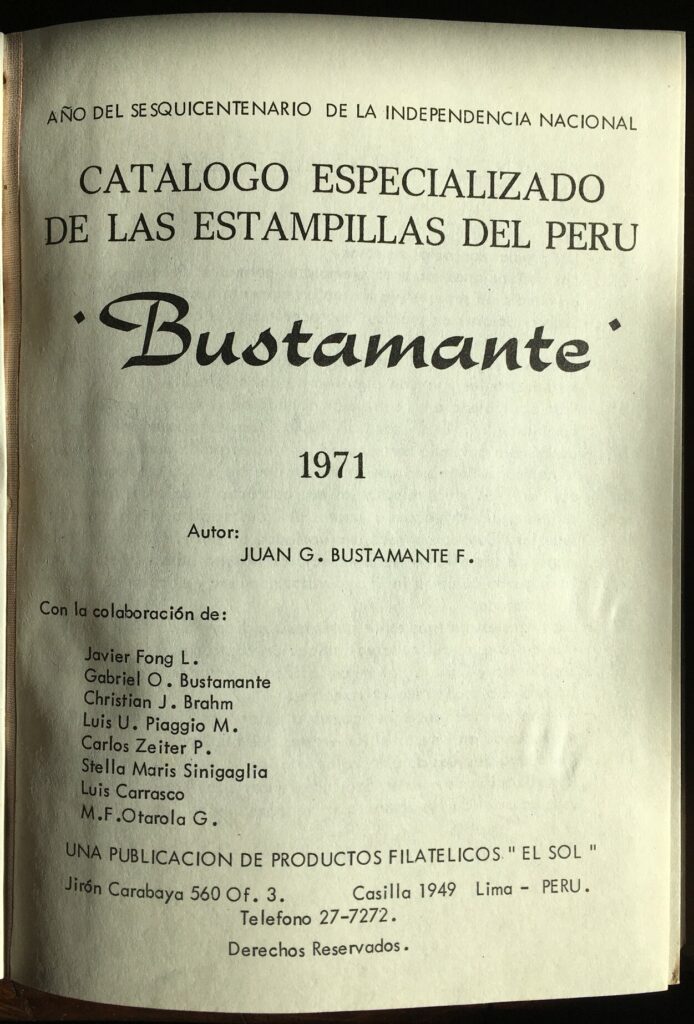
CLA Are you still discovering new information about the first editions of Peru?
YB Peruvian philately is constantly being researched and new discoveries are always being made. This is why we state that what is written is never definitive; there are always new notes and discoveries that scholars of our philately are making every day.
CLA Can you explain the differences between your specialised and simplified catalogues?
YB The difference between the specialized catalogue and the simplified catalogue is that in the simplified ones, only the minimum details of an issue are noted.
The specialized catalogues will contain additional data such as errors, varieties and more extensive notes on each issue including information such as date of printing, dates of use, designers, printer’s details and so on.
CLA Apart from the Bustamante catalogue, are there any other publications on Peruvian philately that you have published?
YB In 2018, on the occasion of our 85th anniversary, we published the five volume Matasellos Sobre Primeras Emissiones del Peru 1859-1876.
This was developed over sixty years with three generations of the Bustamante family contributing to its formation.
For those collectors that wish to focus on the early issues of Peru, we would consider this to be an important support material to help build their collection. We are currently working on a supplementary update as there are always new and important things to add.
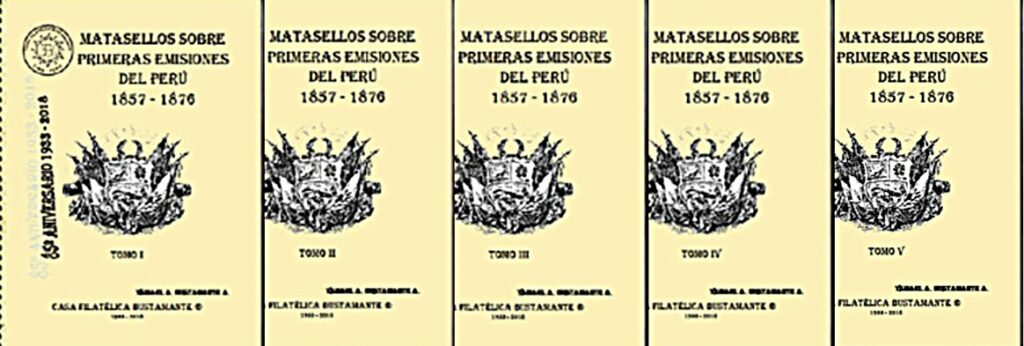
Collecting Peru
CLA Is philately still popular in Peru?
YB Philately in Peru, as everywhere else, has had its ups and downs.
Currently we would definitely say that it is on the rise, not least because of the enthusiasts and active collectors who have been creating forums and using social media to promote the hobby.
CLA How has stamp collecting in Peru changed and evolved over the years? Do you see any emerging trends?
YB As has been said, philately is always evolutionary with each generation exploring new fields and with new horizons opening up.
In Peruvian philately in particular, the attraction of postmarks of the post-classic to modern issues is emerging by leaps and bounds. This is a really interesting and captivating field that has much to explore, discover and learn about.
CLA The collecting of Peruvian early issue cancels has also been popular for many years. Do you feel that the demand in this area continues?
YB This is an area that is still going strong and I believe it will be around for a long time to come. There is still a lot to discover and write about.
CLA To what extent are forgeries a problem with Peru’s classic material, and how can a new collector avoid making costly mistakes?
YB As with issues from most other countries, Peruvian issues in the classical and even post-classical period have been adulterated and counterfeited. For the most part though, to the eye of more advanced collectors, they are easy to detect.
There are several published studies that detail these forgeries. If they are carefully read and if due attention is paid, those who are just getting into the collecting, study and acquisition of these specimens can easily detect them and exclude them from their personal collections.
We always recommend that high-cost specimens should be acquired from specialists and people that know these issues.
We have seen that in some auction houses, even the prestigious ones, fraudulent specimens from Peru have been offered. And of course, there is always false material being offered via the online market places.
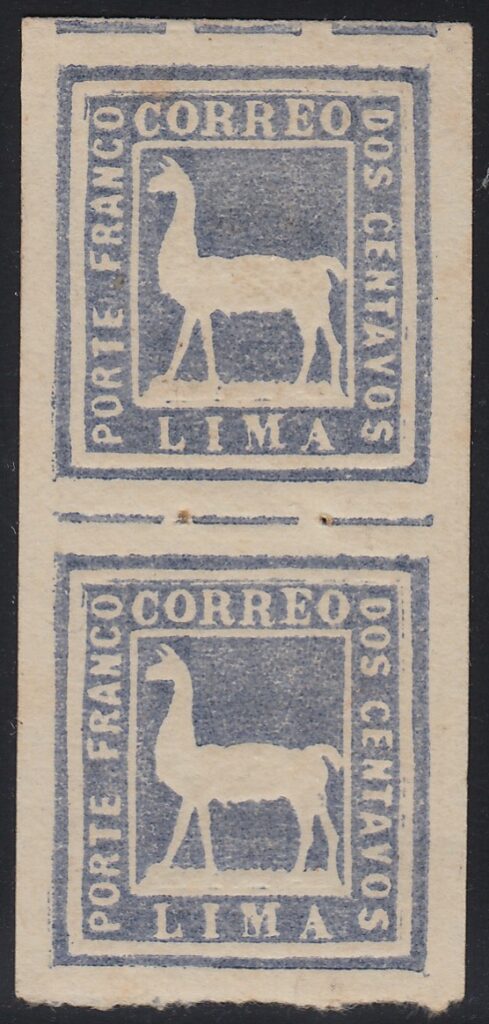
Advice for new collectors of Peru
CLA What areas of Peruvian philately would you recommend a new collector to focus on if they want a relatively inexpensive but interesting area to explore?
YB Peruvian philately really is one of the richest in its diversity of topics, both to study and to collect. They are not necessarily linked to the financial circumstances of the philatelist and, although it is a subject we do not usually touch on, we must remember that philately is not purely an economic investment.
We see it more as a cultural and social investment; an interrelation between different individuals who, by the mere fact of being immersed in this wonderful world, break socio-political, cultural and theological boundaries.
The desire for collecting breaks the differences between those involved and brings them closer together in the midst of a culture of peace and friendship.
But returning to the question. As I’ve mentioned, Peruvian philately has a vast spectrum to collect and explore and it does not have to be expensive.
The diversity of its issues and its different epochs, leaves much to be discovered and is open to the imagination of any curious person. It could be to choose issues of certain printings, to undertake a study on errors and/or varieties, to consider places and dates of use…the list is endless.
The important thing is that the interested party should see what is most appealing to him/her personally and can choose what best suits their situation, without losing sight of the fact that philately is a very personal hobby.
Dedicate the necessary time and funds so that it does not become a stress and you will enjoy a relaxing hobby that provides continuous learning and one which will benefit the person enormously.
A new, limited edition of the specialized Bustamante catalogue will be published in July this year. To reserve a copy, send your contact details to cafilbust@hotmail.com. The number of volumes and pricing will be announced in due course.

I am interested in the 2022 Peru Specialized and the 5 volume early issues catalogue. I would also like to purchase a catalogue or reference of Peruvian revenues and cinderellas.
Send an email to the address above and I am sure you will get a notification when the catalogue is ready. It is likely to be published in July and will probably stretch to five volumes.
Regarding the revenues, look out for a copy of The Revenue Stamps of Peru by Clive Akerman & Herbert Moll. It was last published in 2007 (second edition) and is out of print but copies do occasionally surface on the secondhand market.
I’m also interested in the 2022 Peru Specialized catalogue and publication(s) on Peruvian postmarks, early and late.